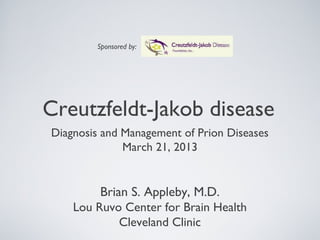
Georgetown University Hospital Dept of Medicine Grand Rounds
- 1. Sponsored by: Creutzfeldt-Jakob disease Diagnosis and Management of Prion Diseases March 21, 2013 Brian S. Appleby, M.D. Lou Ruvo Center for Brain Health Cleveland Clinic
- 2. Disclosures • No relevant financial disclosures • Off-label uses of: • Quinacrine • Pentosan Polysulphate • Doxycycline
- 3. Objectives I. Understand key elements of diagnosing CJD II. Demonstrate strategies for managing patients with CJD III. Demonstrate knowledge regarding CJD risks
- 4. “Pri-on” • proteinaceous and infectious • -ion (infectious, e.g. virion) • No nucleic acid • Non-degradable by typical sterilization
- 5. Soto C, Trends Biochem Sci 2006
- 6. Etiologies Kuru Genetic CJD Iatrogenic CJD Fatal familial insomnia Variant CJD Gerstmann-Sträussler-Scheinker
- 7. Age at Onset sCJD gCJD vCJD Adapted from: Appleby BS, J Neuropsychiatry Clin Neurosci 2007
- 8. Epidemiology sCJD=1/1,000,000 people per year 1/10,000 deaths per year in US due to CJD
- 9. Survival Time Adapted from: Appleby BS, Arch Neurol 2009
- 10. Definitive Diagnosis H&E Immunohistochemistry
- 11. Probable sCJD At least two clinical signs: 1.Dementia 2.Cerebellar or visual symptoms 3.Pyramidal or extrapyramidal symptoms 4.Akinetic mutism At least one of the following: 1.PSWCs on EEG 2.14-3-3 in CSF and disease duration < 2 years 3.High signal abnormalities in basal ganglia or at least two cortical regions (temporal, parietal, or occipital) on DWI/FLAIR sequences on brain MRI Zerr I, et al. Brain 2009
- 12. Electroencephalogram (EEG) Periodic sharp wave complexes (PSWC’s)
- 13. MRI (DWI/FLAIR)
- 14. All stage CJD Early stage CJD Satoh K, Dement Geriatr Cog Disord 2007
- 15. Genetic Prion Disease Kovács GG, J Neurol 2002
- 16. Acquired Prion Disease • Kuru • Iatrogenic CJD (iCJD) • Variant CJD (vCJD)
- 17. Kuru
- 18. Iatrogenic CJD Brown P, Neurology 2006
- 19. Variant CJD 227 total cases http://www.cjd.ed.ac.uk/vcjdworld.htm
- 20. vCJD Characteristics Will RG, Lancet 1996
- 21. Pulvinar Sign Zeidler M, Lancet 2000
- 22. MM MV BSE 1980’s Creutzfeldt-Jakob Disease in the UK, 18th Annual Report, 2009
- 24. Experimental Treatment • Quinacrine and other tricyclic compounds • Pentosan polysulphate (PPS) • Doxycycline
- 25. Quinacrine I. 30 sCJD/2vCJD, no sig diff in survival time (Haik S, Neurology, 2004) II. PRION-1 (UK), 45 sCJD/2 iCJD, 18 vCJD, 42 gCJD, no sig diff in survival time (Collinge J, Lancet Neurol, 2009) III. UCSF, midpoint survival analyses, no sig diff btwn comparison groups (Log rank, p=0.4) (Geschwind M, 6th CJD Family Conference, 2008)
- 26. 45 sCJD, 42 genetic prion disease, 18 vCJD, 2 iCJD Quinacrine PO 1g/24hr then Quinacrine 100mg PO TID Only 2 of 107 subjects chose randomization
- 27. “PRION-1 was essentially an observational study of patients choosing to take quinacrine or not...” Collinge J, Lancet Neurol 2009
- 28. Doh-ura K, J Virol 2004
- 29. Pentosan Polysulphate Bone I, Eur J Neurol 2008
- 30. “On the basis of the available evidence, the best possible outcome that could be expected after treatment with intraventricular PPS is that there may be some temporary slowing or halting of the disease progression. However, there is little likelihood of significant clinical improvement. Nor is there a likelihood of permanent halting of disease progression.” CJD Support Network Newsletter, March 2004
- 31. Doxycycline Observational study Group Number of cases Median survival time Doxycycline treated 21 292 days Untreated 581 169 days Log Rank test, p<0.001 PRNP codon 129 MM, p=0.019 MV, p=0.133 VV, p=0.54 Zerr I, Prion 2008, Madrid, Spain
- 33. Goals Education Communication Implementation
- 34. Intervals of Care I. Pre-clinical/Presentation Phase II. Diagnostic Phase III. Caring Phase
- 35. Preclinical/Presentation Phase • Initial interactions with primary medical doctor • At risk individuals should identify “physician champions” Kranitz FJ & Simpson DM. CNS Neurol Disord Drug Targets 2009
- 36. Diagnosis Phase • Discuss process with patient and family • Don’t forget about present needs • Referto organizations and clinicians familiar with the illness • Discharge planning (before discharge) • Must establish a “key worker” Douglas M, Patients with nvCJD and their families 1999
- 37. Caring Phase • Frequentreassessment/symptomatic treatment • Limitvisits to few individuals of short durations • Assess caregiver requirements • Hospice/Respite care
- 38. Symptomatic Treatment Symptom Suggested Treatment Psychosis/Agitation Low potency neuroleptics (e.g., quetiapine) Myoclonus/Hyperstartle Long acting benzodiazepines (e.g., diazepam) Anticonvulsants (e.g., valproic acid) Seizures Anticonvulsants Dystonia/Contractures Passive movement Long acting benzodiazepines, Botulinum toxin injections Constipation Bowel regimen (e.g., dulcolax) Dysphagia/Rumination Thickener, cueing Behavioral/Environmental changes first Start low and go slow Re-evaluate frequently
- 39. Afterwards • Arrange requested post-mortems prior to death (www.cjdsurveillance.com) • Frequent check-ins with family/caregivers • Ifpostmortem performed, communicate results (in person if possible) • Encourage contact as needed
- 40. Risk Assessment
- 41. Routine Clinical Care • Standard Precautions Only • No need for gowns, masks, isolation, etc. • Consider the family
- 42. Surgery/Equipment • WHO. WHO consultation on TSE in relation to biological and pharmaceutical products. Geneva, Switzerland; 2003 • WHO. WHO guidelines on tissue infectivity distribution in TSE. Geneva, Switzerland; 2005 • Transfusion Medicine Epidemiological Review (TMER) ( http://www.cjd.ed.ac.uk/TMER/TMER.htm)
- 43. Case • 57 y.o. AAM professional, h/o 3 TBI’s • Some short term memory problems x 3 months • More distractible, still working full time • MMSE=24/30 (-1 calculation, -3 orientation, -2 recall) • mild left upper extremity dysmetria
- 45. Summary • Diagnosing CJD can be difficult and frustrating • Getting a proper diagnosis and managing the care of a patient with CJD is stressful • Care and management of patients with prion disease is supportive and entails several disease specific interventions
- 46. Thank You!